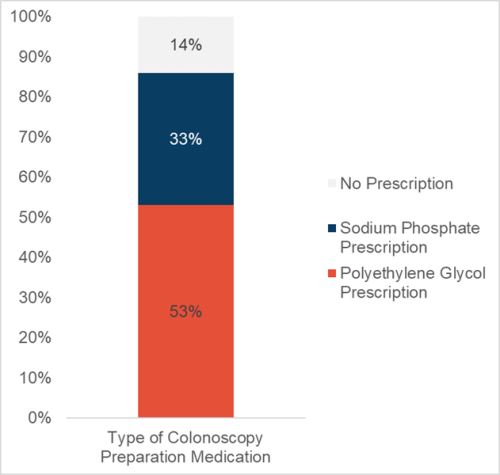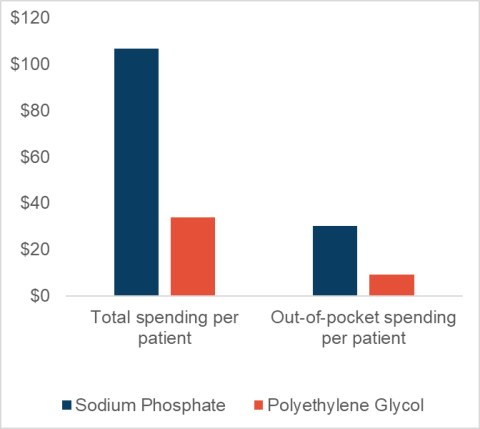Colorectal cancer is the third most common cancer diagnosed in the U.S., and the second most common cause of cancer deaths among men and women combined. Screening via colonoscopy is highly effective in terms of improving prognosis of colorectal cancer via early detection; over 90% of patients who are diagnosed early (i.e., when the cancer is small and has not spread) live five years or longer, compared to fewer than 15% of those diagnosed later.
The accuracy of a colonoscopy depends on effective preparation, which ensures that the bowel can be properly visualized. To prepare for a colonoscopy, patients consume a liquid solution containing a medication (usually a tablet or powder dissolved in water).
Patients have two choices for colonoscopy preparation medications: polyethylene glycol (PEG) products (e.g., MoviPrep or GoLYTELY) or sodium phosphate products (e.g., SUPREP or OsmoPrep). Both are consumed orally, and, if properly consumed, are equally effective at preparing the bowel for a colonoscopy. The options vary, however, in amount and taste and, therefore, in how easily patients can tolerate them. PEG and sodium phosphate solutions also differ in cost, both to insurers and patients, with sodium phosphate solutions as the more costly option.
PEG solutions typically require patients to consume a total of 2 to 4 liters of fluid over a few hours, in 8-ounce proportions every 10 minutes. Generally, patients find the poor taste and high volume difficult to tolerate, which contributes to lower compliance. Sodium phosphate solutions were introduced as a gentler alternative to PEG bowel preparations. These medications taste better, and require a much smaller volume intake, with only two 1.5-ounce doses consumed 10 to 12 hours apart.
Using HCCI’s data on people with employer-sponsored health insurance, we examined spending and utilization patterns of the two types of colonoscopy preparation medications in 2021. We find that:
- More than half of patients use PEG medications to prepare for a colonoscopy, despite being more difficult to tolerate. In 2021, among people with prescription drug coverage who received a colonoscopy, 53% filled a prescription for a PEG medication. One-third (33%) filled a prescription for a sodium phosphate medication, and 14% did not fill any prescription (Figure 1). People with no prescription may have purchased an over-the-counter medication (e.g., Miralax) or paid the full cost of their bowel preparation medication out-of-pocket (e.g., if they wanted a sodium phosphate medication but it was not covered by their insurance). Higher use of PEG medications may be due, in part, to their lower costs. Additionally, they are reported to be the preferred medication among clinicians, and they have been widely available longer than sodium phosphate solutions.
Figure 1. Over Half of Patients Used PEG Medications to Prepare for a Colonoscopy in 2021

- Total spending for sodium phosphate medications was more than 3 times higher than spending for PEG medications. As shown in the Figure 2, total per person spending on sodium phosphates was $107, on average. In comparison, total average per person spending on PEG medication was $34.
- Out-of-pocket spending for sodium phosphate was also 3 times higher than for PEG medications. Similar to total spending, HCCI’s data show that average out-of-pocket spending on a sodium phosphate medication was higher than average out-of-pocket spending on a PEG prescription. In 2021, per person out-of-pocket spending on a sodium phosphate medication was $30, more than three times higher than for a PEG medication ($9 on average).
Figure 2. Total and Out-of-Pocket Per Person Spending on Sodium Phosphate Medications was More than 3 Times Higher than PEG Medications

The effectiveness of colonoscopy screening is widely understood, yet preparing for the procedure poses several barriers to people accessing care. The more palatable option for patients comes with a higher price tag for both insurers and patients. The less costly option is harder for people to tolerate, which threatens the effectiveness of the procedure. Better alignment between the cost of preparation medications and patient preferences may increase compliance with bowel preparation, and, therefore, the success of colonoscopy screenings.
